Backflow Preventer Testing
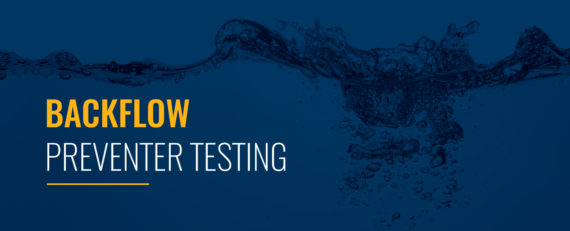
Many people have devices called backflow preventers in their homes and businesses. These tools allow water to flow in one direction, but prevent it from flowing in the opposite direction, preventing non-potable water from entering potable water lines. Local governments and water authorities mandate annual testing of these backflow prevention devices to make sure they work. However, getting licensed to do backflow testing is extensive and costly, so not many plumbers go through with it. That’s where Summers & Zim’s comes in.
Summers & Zim’s is a certified backflow tester, providing backflow testing in PA. We can provide all the details you need to know about backflow and backflow prevention.
Are you interested in learning more about backflow and when to test it? Read on!
What Is Backflow?
At its most basic, a “backflow” occurs when a water line reverses direction and sucks unclean water into the water supply system. Typically, clean, potable water passes along a route, flowing from the water supply system, through a water line and to the destination. If the potable water reverses direction and goes back into the water supply, the negative pressure sucks dirty, non-potable water into the clean water supply system. If the non-potable water gets contaminated with pollutants or pathogens, it can cause severe health and safety issues.
Types of Backflow
You may hear other terms about backflow. These include the following.
-
Back-siphonage
This form of backflow results from negative pressure in the waterline. It effectively sucks water from the potentially contaminated source and into the public water system.
-
Backpressure backflow
This issue occurs as a result of downstream pressure, which means the pressure from the non-potable water source is higher than the pressure of the public water source.
Both of these types of plumbing backflow are severe issues that backflow specialists must correct as quickly as possible.
What Causes Backflow?
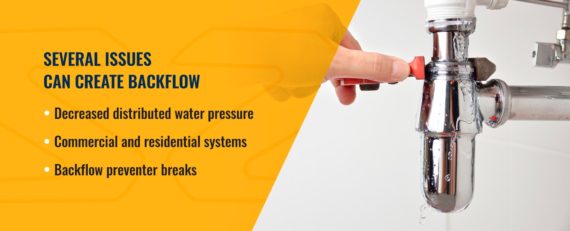
Probably the biggest misconceptions about backflow is that it results from clogs in a plumbing system. That is most certainly not the case. Clogs stop wastewater from exiting the system as intended, while backflow pulls that wastewater in the opposite direction.
Now that we’ve gotten that out of the way, several issues can create backflow. Read on for detailed descriptions.
-
Decreased distributed water pressure
Plumbing systems rely on a delicate balance of pressure. Most water systems operate around 20 psi at all times. Too much pressure in one direction can cause burst pipes and other issues. However, the pressure from the municipal water source must be higher than the pressure from the outside. If the pressure becomes imbalanced in the opposite direction, backflow can develop. This problem can result from breaks in the water main or firefighting operations that use a large enough amount of water to change the pressure within the system.
-
Commercial and residential systems
Sometimes, backflow can occur at a single location due to the presence of systems that operate at higher pressures than that of the distribution system. These systems can then force water back into the source system, causing backflow. Some examples of this include commercial boilers and steam heating systems.
-
Backflow preventer breaks
Because of the issues backflow presents, backflow preventer valves are a requirement throughout any water system. These devices prevent backflow from occurring. However, poor installation and age can cause these devices to leak or malfunction. As time passes, the wear and tear on a backflow assembly from environmental conditions and use can cause parts to break down. When this occurs, the backflow system may stop functioning properly, and backflow can occur.
If these circumstances occur and backflow happens, the consequences can be severe.
What Problems Can Backflow Cause?
The dirty water that siphons back into the main water supply line can contain any number of contaminants, depending on the source. Because water lines connect to all buildings, both commercial and residential, potential contaminants vary widely. Some examples of potential pollutants include:
- Fertilizers and pesticides from agricultural sources
- Human waste from commercial and residential restrooms
- Chlorine from public and private pools and spas
- Soap from sinks, dishwashers or showers
As an example, one Texas town experienced colored, distasteful water caused by back-siphonage from an unprotected funeral home. Another community in New Mexico experienced backflow from an ethanol plant, resulting in several chemicals leaking into the public water supply that caused several residents to become ill.
While the exact number of illnesses caused by backflow is challenging to track, the EPA and CDC have completed studies in the past. Between 1981 to 1998, the CDC documented 57 disease outbreaks resulting from backflow, resulting in 9,734 illnesses. The EPA, however, noted that the number is likely higher due to under-reporting. Depending on the contaminant, those affected by backflow-related sickness have experienced everything from mild fever and gastrointestinal distress to lifelong disabilities and even death. Many homeowners wonder how to prevent backflow issues and related health hazards. Here is where backflow prevention systems come into play.
What Is a Backflow Preventer?
A backflow preventer is the best weapon in the arsenal of keeping water clean. A backflow preventer gets installed in residential and commercial water pipes. It has only one job: allowing water to flow in one direction, while preventing it from flowing in the opposite direction.
Backflow preventers can be very simple or extremely complex, but most operate using similar principles. Most units consist of a series of backflow preventer valves. Their specific arrangement varies based on the construction, but they all work to prevent backflow during times of unequal water pressure or pressure fluctuations. When installed and maintained correctly, any type of backflow preventer can help keep the water supply clean and safe.
Types of Backflow Preventers
Several different types of water backflow prevention devices exist. We’ve described the most common four below.
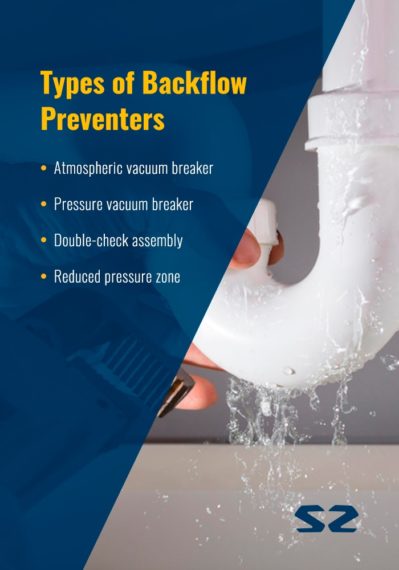
-
Pressure vacuum breaker
Pressure vacuum breaker assemblies are the most common and inexpensive type of backflow prevention devices. With their simple design, consisting of a few valves and a pressure vacuum breaker, these backflow preventers are easy to install, maintain and repair. They are more likely to leak than other assemblies, but they are otherwise highly effective.
-
Double-check assembly
Double-check assemblies, or DCAs, are also called double-check valves. These assemblies are best for indoor and underground installations, and are a good choice in areas where backpressure may be an issue. A DCA consists of two independently operating spring-loaded check valves, in addition to the normal intake and outlet valves.
-
Reduced pressure zone
Reduced pressure zone assemblies are the most complex and expensive backflow prevention equipment, but are also the most secure and reliable. These assemblies consist of two independently operating spring-loaded check valves, like the DCA. However, a pressure differential relief valve in the reduced pressure assembly prevents these check valves, providing more complete protection.
-
Atmospheric vacuum breaker
Atmospheric vacuum breakers, or AVBs, are fairly common, non-testable backflow preventers. These often feature in simple irrigation systems, with an AVB installed after every control valve to help prevent backflow. While these installations are the least expensive and most straightforward out of all the backflow preventers above, they are the least reliable and least recommended. Most municipalities do not allow the use of AVB assemblies, even in lawn sprinkler systems.
Which of these is right for you depends on several factors. Regardless of the one you use, however, you need periodic inspection and maintenance to ensure they continue working their best.
Do You Have a Backflow Preventer?
Chances are, you have a backflow preventer installed on your property. Many counties require residents with irrigation systems or wells have backflow preventers installed at their water meters. Almost all municipal plumbing codes require the installation of backflow preventers in commercial and large residential buildings. Newer homes are especially likely to have backflow preventers installed, as they have become more ubiquitous in plumbing construction in recent years.
If you know you don’t have a water backflow preventer, however, we highly recommend having one installed. Not only do they help maintain your home’s water pressure, but they also help preserve the quality of your local water supply.
If you’re not sure whether you have a backflow preventer, or if you want one installed, have a certified plumber inspect your home’s water system. They’ll be able to tell you more about your system and install backflow preventers where they are needed.
Is Backflow Preventer Testing Necessary?
Both municipal and state plumbing codes vary, but most states require the presence and regular testing of backflow prevention devices. Buildings that fall under these codes need annual testing. Failure to comply may involve nasty enforcement actions like steep fines. These codes may be more lenient for residential applications, however.
Even if your local plumbing codes do not require you to do so, we strongly recommend you have your backflow prevention devices checked annually to help ensure that they are working properly.
When Do I Need Backflow Testing?
If you have a backflow prevention system, it’s your responsibility to make sure it is working properly. Not only can backflow affect your water supply, but it can impact the water quality of your neighbors and community at large. If you’re not quite sure when you should do testing, or have never had your backflow prevention system tested before, we’re here to help.
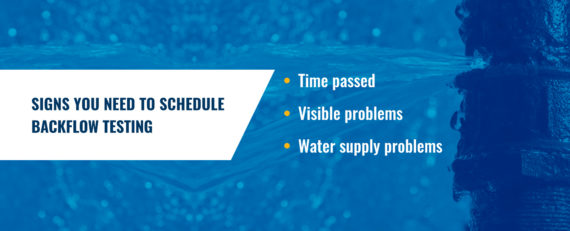
Here are the three signs you need to schedule backflow testing immediately.
-
Time passed
The most significant sign that you need backflow testing is that you haven’t had it checked since you had it installed. This issue is common among property owners. If you’ve never had your backflow checked, or if it’s been more than a year since your last test, schedule one immediately. Annual backflow testing ensures your plumbing is up to code, and can catch issues related to valve age, which are more difficult to spot.
-
Visible problems
Sometimes, it’s easy to see that your backflow prevention device doesn’t look right. It could be a small leak, sporadic discharge, warping or something else visibly wrong with it. Even small flaws can indicate a more significant underlying problem. If you notice anything unusual, call a certified backflow testing company to determine whether or not you need to get your assembly.
-
Water supply problems
The most severe and dangerous sign of a backflow system problem is a contaminated clean water supply. If your water supply looks cloudy or discolored, whether it’s the water from your sink, your hose or your shower, stop interacting with and drinking it immediately. Backflow contamination can release dangerous pathogens and contaminants into your drinking water that can cause serious illness and injury. As soon as you see an issue, have a professional come in to check your backflow prevention assembly and resolve the problem.
If any of these issues apply to you and your water system, it’s time to call in a backflow testing professional.
Backflow Preventer Testing From Certified Plumbers
Because of the importance of backflow testing, only a certified plumber should perform backflow prevention device testing. This certification indicates the plumber has undergone the necessary training and possesses the knowledge and skills to appropriately assess and repair backflow assemblies.
The vast majority of municipalities and states require that only plumbers certified in backflow compliance and repair can take a look at backflow prevention devices and apply valid backflow prevention tests. These valid tests provide proof of backflow compliance for properties that must complete regular tests of backflow prevention devices. However, very few plumbers pursue certification due to the extensive and costly certification process.
These certified plumbers are particularly rare in Pennsylvania, which is where Summers & Zim’s can help! Summers & Zim’s is a state-certified backflow testing company that helps utility companies and commercial customers in the central PA area by providing backflow testing. Because we are a certified backflow tester, we can complete the required backflow tests you need to stay compliant with your utility company. Contact us to book an appointment as soon as possible.
Choose Summers & Zim’s to Test Your Backflow Prevention Devices
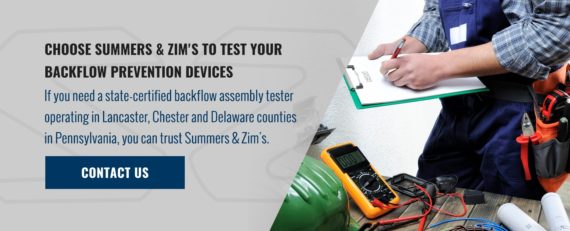
At Summers & Zim’s, our mission statement is to capture the hearts of the best customers for life. It may sound like a marketing slogan, but it’s a mission we live by every day. For four generations, we’ve operated intending to serve our customers to the best of our ability, creating lifetime customers who can trust us for quality service every time.
If you need a state-certified backflow assembly tester operating in Lancaster, Chester and Delaware counties in Pennsylvania, you can trust Summers & Zim’s. We’ll work with you every step of the way, providing assessments, consultations and action plans, so you can get the results you need to feel safe with your water supply.
Contact Summers & Zim’s today to learn more about our backflow testing services.
Why Choose Summers & Zim’s
Why should you trust the plumbing professionals at Summers & Zim’s for all your residential HVAC needs? At Summers & Zim’s, we pride ourselves on our good natured disposition, unmatched HVAC experience paired with numerous certifications and focus on providing our customers with exceptional service and personalized HVAC repair and installation solutions. We’re proud to be certified by the North American Technician Excellence, Inc. and the Environmental Protection Agency.
With our dedication to our customers, we also ensure consistent quality and satisfaction with our one-of-a-kind 5 Point Guarantee:

-
Design Guarantee
At Summers & Zim’s, we’re committed to excellence in every repair and installation we undertake. Our Design Guarantee ensures that the work we do not only meets but exceeds your expectations. Whether it’s a complex HVAC installation or a routine plumbing fix, we promise that it will function exactly as intended. If, for any reason, you feel that the results aren’t what you were expecting, our team is prepared to make necessary adjustments or replacements, completely free of charge. We’re not satisfied until you are, ensuring your home’s systems are both efficient and reliable.
-
No Lemons Guarantee
We understand the frustration of a new plumbing fixture failing to perform as expected. With our No Lemons Guarantee, you have our assurance of quality and reliability. If any plumbing fixture we’ve installed in your home shows signs of malfunction or unreliability, rest assured, we will replace it with a new one at no additional cost. This guarantee is our promise of quality and your peace of mind, ensuring that your plumbing investments are secure and reliable.
-
$500 No Frustration Guarantee
Your satisfaction is our top priority, and we stand firmly behind the quality of our plumbing installations. With our $500 No Frustration Guarantee, we take our commitment to a higher level. If any new plumbing installation we provide doesn’t perform as promised or expected within the first two years, we acknowledge the inconvenience it causes. To make it right, we will compensate you with $500. This guarantee underscores our dedication to providing services that not only meet but exceed your expectations.
-
Home Protection Guarantee
At Summers & Zim’s, we treat your home with the utmost care and respect. Our Home Protection Guarantee ensures that in the unlikely event our team accidentally causes any damage to your home during our service, we will bear the cost of all necessary repairs or replacements. We strive to work meticulously, but should any mishaps occur, you can have peace of mind knowing that we will take full responsibility to restore your home to its original condition, or better.
-
100% Money Back Guarantee
Your trust in our system installations is valued, and we aim to deliver solutions that perfectly match your needs and expectations. Our 100% Money Back Guarantee is a testament to this commitment. If you find that a new system installation by Summers & Zim’s does not fulfill your requirements or live up to your expectations, we will not only remove the installation but also return every penny of your investment. This guarantee is our way of ensuring that your investment in your home’s systems is completely risk-free.

